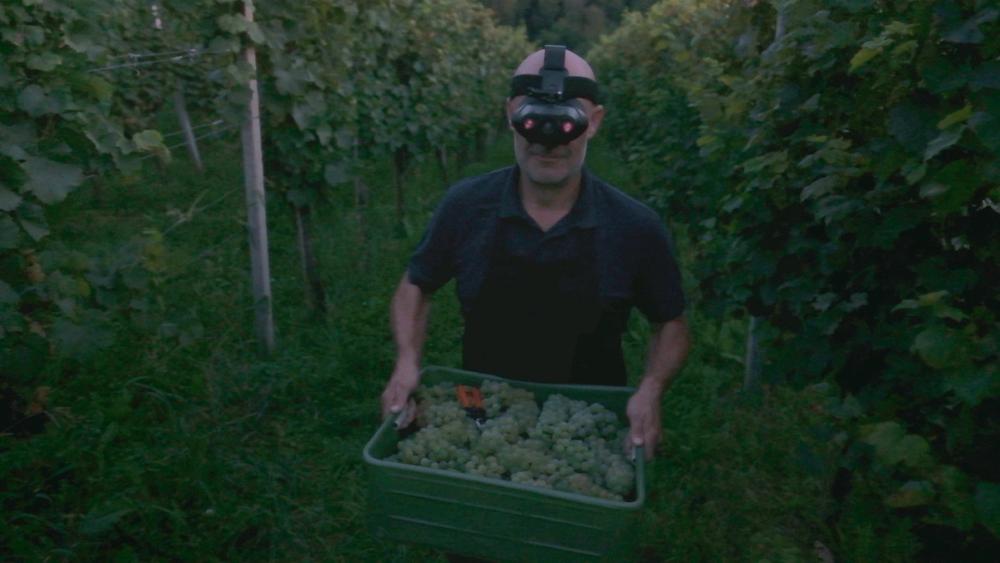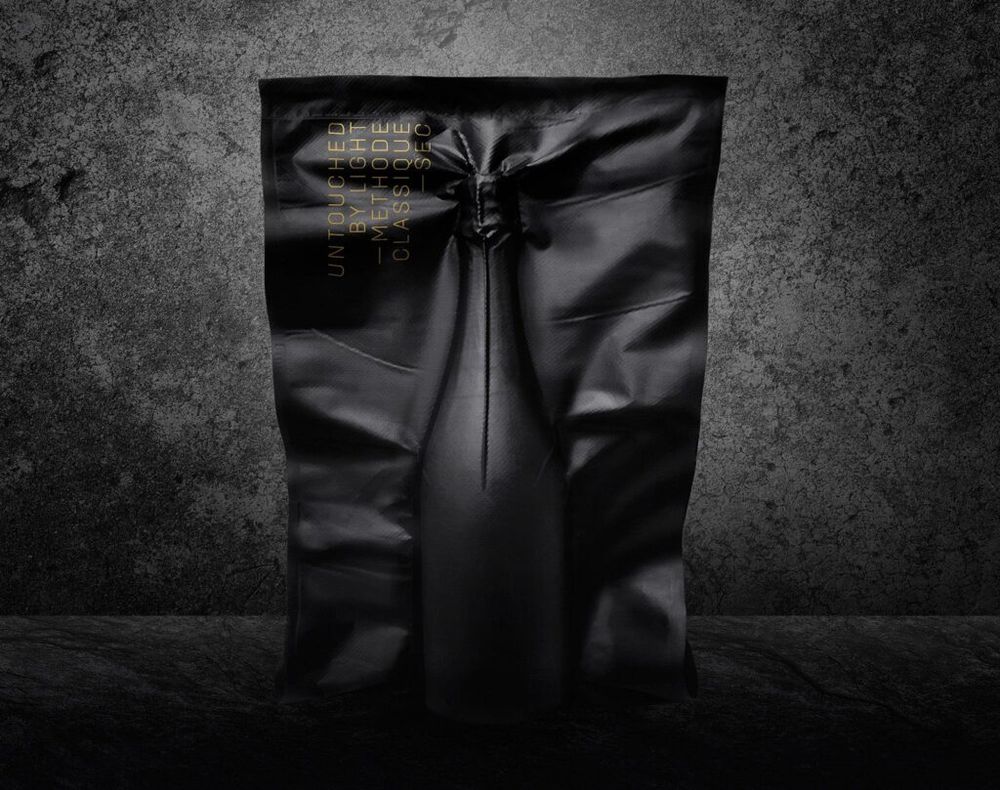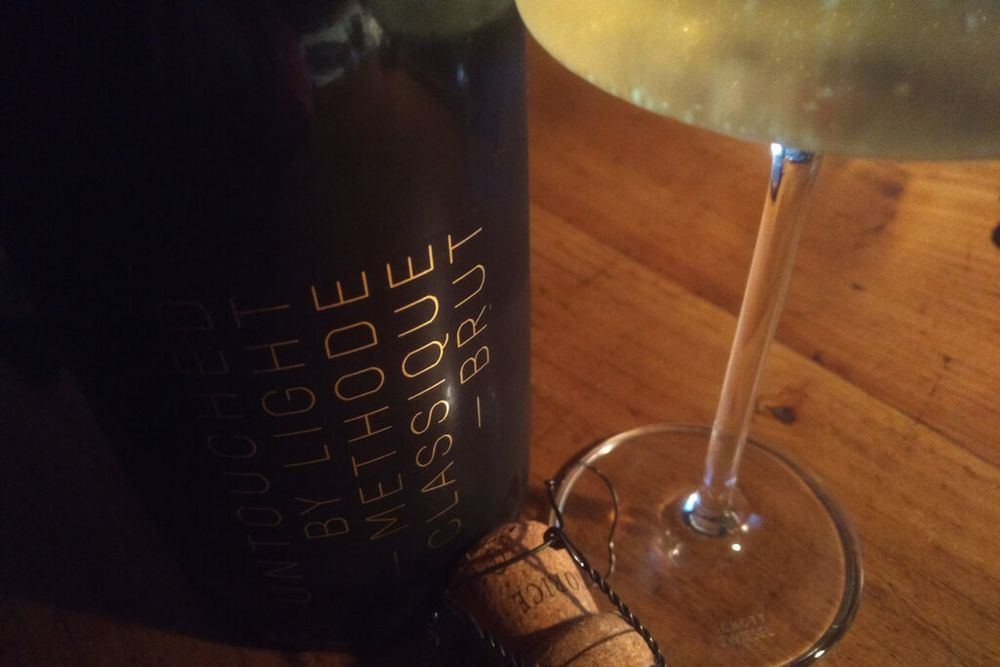“Knowing the pristine nature of both Styrian and Stajerskan wines, my expectations were high,” writes Krebiehl.
The Radgonske Gorice winery in Slovenia pulled a great stunt: they decided to make a sparkling wine produced completely in the dark. Yes, you read that right, in the dark – with the help of night vision goggles during a night harvest, pressing, settling, fermenting, bottling and disgorging. The idea was sparked by Professor Ann C. Noble’s research – yes, the sensory scientist at UC Davis who gave the world the wine flavour wheel – which now has iterations for everything from chocolate to whisky. Noble had found that light alters flavour and damages wine, creating off-flavours like ‘wet dog’ and ‘cabbage’. We know this problem as light strike or gout de lumière.

Night harvest with the aid of goggles
Radgonske Gorice focused on one particular paper, namely the 1989 publication Sensory study of the effect of fluorescent light on a sparkling wine and its base wine[1], and decided to make a wine completely in the dark. The sample bottle arrived completely sealed in a black plastic vacuum pack with gold lettering “designed to maintain the darkness until you consume it”. We were exhorted to switch off electric lights and even dim the brightness of our computer screens as we attended the zoom premiere of this world first, streamed from the town of Gornja Radona on Thursday night. It would be the very first time the wine would see the light. The recommendation was accompanied by the slightly suggestive notion that “the best things happen in the dark.”
I was curious – because I love sparkling wine and because the winery is in Slovenia, just on the border to Styria, a region whose wines I adore and drink. So, of course, I needed to taste that. The fact that the wine was made from 100% Chardonnay was fortuitous because it allowed for comparison with other Blanc de Blancs (wouldn’t a Blanc de Noirs have been a better choice? – Ed.)
Radgonske Gorice had gone to huge effort to make this memorable. They had hired a presenter and invited journalists across the globe to attend the Zoom launch: people from the US, Asia, Scandinavia and continental Europe had numerously joined and signed in with greetings from their respective locations. At the winery itself, guests had been assembled, distanced of course, and the entire event was stage managed. There even were interludes of music by a prominent Slovenian singer-songwriter.

Klavdija Topolovec Špur: “Happy and surprised”
The winemaker Klavdija Topolovec Špur modestly said a few words about this idea they had in 2016 and what a challenge it was to put it into practice but it was the presenter who was fond of hyperbole, hailing the tasting as “a complete sensory experience that happens in the dark.” He said:”Untouched by Light is the latest and perhaps the greatest creation of this vineyard, based on incredible research.” He even went as far as saying that this was a new “crafted by darkness method.” Technical detail – about soil, about winemaking, was absent – apart from the notion that the wine was bottled in 99.8% black glass.
Radgonske Gorice is a winery with a 168-year track record in making sparkling wine, sitting in the former heartland of the Habsburg Empire where the progressive Archduke Johann of Austria (1782-1859) did so much to improve viticulture and the lot of farmers. They own 480 hectares of vineyards and produce 4,500,000 litres of wine annually. The wines are matured in 200-year-old cellars that were once used as stores for ice from the river Mur in this beautiful, green and undulating part of north-eastern Slovenia.
Knowing the pristine nature of both Styrian and Stajerskan wines, my expectations were high.

Untouched by Light
The scene then switched to the cellar where CEO Borut Cvetkovič said: “today we will offer to the world something different and something unique. We invested a lot of effort and knowledge in this product – today it is about to see the light of the world.” But we had to wait even longer while Pierre Yves Bournerias from the Institut Oenologuique de Champagne averred on camera that this was indeed a world first. Then, at long last, the screen went dark. The people in the cellar had donned night-vision-goggles once again, opened and poured the bottle. Bournerias was the first to give his verdict – even before the winemaker Topolovec Špur herself who said, after tasting, that “I am happy, I am surprised, we are producing sparkling wine exactly as we want.”
As the guests in the cellar tasted, so did we. We were invited to give our verdicts and ask questions. This is when technical detail emerged:
2000 bottles were made in 2016. Topolovec Špur said that malo-lactic fermentation had “not been necessary.” Tirage was in April 2017 and disgorgement early in 2020 after 36 months on lees – she was vague about the dosage. The wine can be bought online for €100.00
The press release, which arrived today, provided some more detail: the grapes, from a selected, south-facing Chardonnay plot planted in 1989 were grown in “Eutric brown soil with limestone gravel admixture.” The final wine has 8g of acidity, and a dosage of 6.9g/l at 12% ABV.

Radgonske Gorice, Untouched by Light Methode Classique Brut, 2016, Stajerska, Slovenia
A creamy, chalky, fresh nose is inviting, promising and bright. On the palate there is lightness with a mild and gentle freshness. The body is slender with very subdued autolysis, gentle creaminess and gentle, fine bubbles. There is something elegant and subdued about it. A lovely, gentle, fresh wine with a certain creaminess – but I personally had hoped for more acidity, zing and length. I hope they have not disgorged all the bottles because this elegant Chardonnay will benefit from more ageing on lees. Could I taste the darkness? No, not really. All in all, it is a mild, elegant Blanc de Blancs that is very approachable. Kudos to Radgonske Gorice for going to all of that effort and for drawing attention to the very real problem that is light strike.
[1]Noble, Ann C., Sensory study of the effect of fluorescent light on a sparkling wine and its base wine, American Journal of Enology and Viticulture, Vol. 40, No. 4, 1989.
































